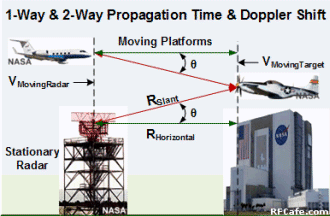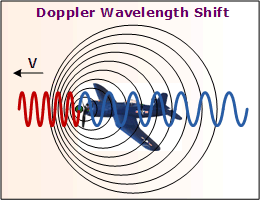Doppler Frequency Shift |
|
Radar systems exploit the Doppler shift to provide an indication of relative speed. When the two objects are approaching each other (closing), the Doppler shift causes a shortening of wavelength (increase in frequency). When the two objects are receding from each other (opening), the Doppler shift causes a lengthening of wavelength (decrease in frequency). For a Doppler radar system to measure speed, an accurate measurement of the original transmitted frequency and the reflected return frequency is required. The difference in the two frequencies is the termed the Doppler frequency shift, and is a direct indication of the object's speed as indicated in the equations below. The measured speed is relative to a straight line directly from the radar to the target (RHorizontal) - not its speed relative to the ground (RSlant). To calculate ground speed, the target's height relative to the radar antenna must be known, and that can be inferred from the elevation angle of the antenna (known as boresight angle, θ).
Note that the angle shown (θ) is for elevation differences only. If there is also an azimuthal angle, it must be factored into the equation as cos (α), where 'α' is the azimuth angle relative to the radar antenna boresight direction. RHorizontal = RSlant * cos θ. In the following equations, distance can be expressed in any convenient units as long as they are consistent for both 'V' and 'c,' that is, km/hr, mi/hr, cm/week, furlongs/fortnight, etc. Use positive velocity (+) when the target is moving away from the radar and negative (-) when moving toward. 'c' is the speed of light. fTransmitted should have units of Hz since the Doppler shift is usually no more than a few kHz. Note: When using these formulas, be sure to keep dimensional units consistent; i.e., do not mix kHz with MHz, mm with inches, etc. It is safer to use base units (e.g., Hz, m) for calculation, then convert result to desired units. Here is information on propagation time, radar equation, and path loss. Radar Doppler Frequency Shift Equation
This equation applies generally to any value of VMovingTarget; however, for VMovingTarget << c, VMovingTarget - c → c and the equation simplifies to the ones shown below. Note: The factor of 2 in the equation is due to a Doppler shift occurring both for the incident and reflected wave. When calculating Doppler shift from an emitter, such as light from a star or from a satellite, replace 2 with 1. Example 1: An airplane moving at Mach 1 along the antenna boresight of a 10 GHz radar creates a Doppler shift of 22.87 kHz. Example 2: The SCR-270 radar in use at Pearl Harbor during the Japanese attack on December 7, 1941, operated at 106 MHz and an A6M Zero attack aircraft had a diving speed of around 400 mi/hr. That corresponds to a Doppler shift of a mere 633 Hz. Fixed Radar with Moving Target
where VMovingTarget is relative to the stationary radar. Moving Radar with Moving Target
where VMovingRadar and VMovingTarget are relative to a fixed point on the ground.
You might also want to check out the Doppler Shift section of the Electronic Warfare and Radar Systems Engineering Handbook. |





